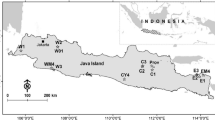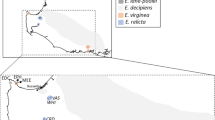Abstract
The nurse effect is a positive interaction in which a nurse plant improves the abiotic environment for another species (beneficiary plant) and facilitates its establishment. The evergreen shrub Vaccinium vitis-idaea (a beneficiary plant) grows mainly under the dwarf shrub Pinus pumila (a nurse plant) in the alpine regions of central Japan. However, whether V. vitis-idaea shrubs under various P. pumila shrubs spread through clonal growth and/or seeds remains unclear. We investigated the clonal structure of V. vitis-idaea under the nurse plant P. pumila in Japanese alpine regions. MIG-seq analysis was conducted to clarify the clonal diversity of V. vitis-idaea in isolated and patchy P. pumila plots on a ridge (PATs), and in a plot covered by dense P. pumila on a slope adjacent to the ridge (MAT) on Mt. Norikura, Japan. We detected 28 multilocus genotypes in 319 ramets of V. vitis-idaea across 11 PATs and MAT. Three genets expanded to more than 10 m in the MAT. Some genets were shared among neighboring PATs or among PATs and MAT. These findings suggest that the clonal growth of V. vitis-idaea plays an important role in the sustainability of populations. The clonal diversity of V. vitis-idaea was positively related with the spatial size of PATs and was higher in MAT than in PATs at a small scale. Therefore, the spatial spread of the nurse plant P. pumila might facilitate the nurse effect on the genetic diversity of beneficiary plants, leading to the sustainability of beneficiary populations.



Similar content being viewed by others
Data availability
Data are available on request from authors.
References
Araki M (1998) Analysis on propagation system of Japanese stone pine (Pinus pumila) with synchronization of annual shoot elongation among shoots. Jpn J For Environ 40:9–16. https://doi.org/10.18922/jjfe.40.1_9
Araki M, Tani N, Araki M, Morikawa M (1993) Community structure and growth habit of Siberian dwarf pine (Pinus pumila). J Jpn For Soc 75:463–468. https://doi.org/10.11519/jjfs1953.75.5_463
Arroyo MTK, Cavieres LA, Peñaloza A, Arroyo-Kalin MA (2003) Positive associations between the cushion plant Azorella monantha (Apiaceae) and alpine plant species in the Chilean Patagonian Andes. Plant Ecol 169:121–129. https://doi.org/10.1023/A:1026281405115
Ballantyne M, Pickering CM (2015) Shrub facilitation is an important driver of alpine plant community diversity and functional composition. Biodivers Conserv 24:1859–1875. https://doi.org/10.1007/s10531-015-0910-z
Bolger AM, Lohse M, Usadel B (2014) Trimmomatic: a flexible trimmer for Illumina sequence data. Bioinformatics 30:2114–2120. https://doi.org/10.1093/bioinformatics/btu170
Catchen JM, Amores A, Hohenlohe P, Cresko W, Postlethwait JH (2011) Stacks building and genotyping loci de novo from short-read sequences. G3(Bethesda) 1:171–182. https://doi.org/10.1534/g3.111.000240
Catchen J, Hohenlohe PA, Bassham S, Amores A, Cresko WA (2013) Stacks: an analysis tool set for population genomics. Mol Ecol 22:3124–3140. https://doi.org/10.1111/mec.12354
Dorken ME, Eckert CG (2001) Severely reduced sexual reproduction in northern populations of a clonal plant, Decodon verticillatus (Lythraceae). J Ecol 89:339–350. https://doi.org/10.1046/j.1365-2745.2001.00558.x
Franco AC, Nobel PS (1988) Interactions between seedlings of Agave deserti and the nurse plant Hilaria rigida. Ecology 69:1731–1740. https://doi.org/10.2307/1941151
Haase P, Pugnaire FI, Clark SC, Incoll LD (1996) Spatial patterns in a two-tiered semi-arid shrubland in southeastern Spain. J Veget Sci 7:527–534. https://doi.org/10.2307/3236301
Honnay O, Jacquemyn H (2008) A meta-analysis of the relation between mating system, growth form and genotypic diversity in clonal plant species. Evol Ecol 22:299–312. https://doi.org/10.1007/s10682-007-9202-8
Ikeda H, Yoneta Y, Higashi H, Eidesen PB, Barkalov V, Yakubov V, Brochmann C, Setoguchi H (2015) Persistent history of the bird-dispersed arctic-alpine plant Vaccinium vitis-idaea L. (Ericaceae) in Japan. J Plant Res 128:437–444. https://doi.org/10.1007/s10265-015-0709-8
Jacquemart AL (1993) Floral visitors of Vaccinium species in the high Ardennes, Belgium. Flora 188:263–273. https://doi.org/10.1016/S0367-2530(17)32276-4
Kobayashi A, Nakamura H (2011) Seasonal change of food items of the Japanese Rock ptarmigan (in Japanese with English summary). Jpn J Ornithol 60:200–215. https://doi.org/10.3838/jjo.60.200
López RP, Valdivia S, Sanjinés N, de la Quintana D (2007) The role of nurse plants in the establishment of shrub seedlings in the semi-arid subtropical Andes. Oecologia 152:779–790. https://doi.org/10.1007/s00442-007-0698-y
Murray MG, Thompson WF (1980) Rapid isolation of high molecular weight plant DNA. Nucleic Acids Res 8:4321–4325. https://doi.org/10.1093/nar/8.19.4321
Nakano T (1996) Ecology of Vaccinium vitis-idaea in a wind exposed area of alpine region of Mt. Norikura. Dissertation, Tokyo Metropolitan University
Nishimura M, Tanaka R, Sasaki A, Suzuki K (2022) Spatiotemporal variations of snow cover in Mt. Norikura, the Northern Japanese Alps. Jpn J Mountain Res 5:1–12
Nuñez CI, Aizen MA, Ezcurra C (1999) Species associations and nurse plant effects in patches of high-Andean vegetation. J Veget Sci 10:357–364. https://doi.org/10.2307/3237064
Okitsu S, Ito K (1983) Dynamic ecology of the Pinus pumila community of Mts. Taisetsu, Hokkaido, Japan. Environ Sci, Hokkaido 6:154–184
Peláez M, Dirzo R, Fernandes GW, Perea R (2019) Nurse plant size and biotic stress determine quantity and quality of plant facilitation in oak savannas. Forest Ecol Manag 437:435–442. https://doi.org/10.1016/j.foreco.2019.02.010
Persson HA, Gustavsson BA (2001) The extent of clonality and genetic diversity in lingonberry (Vaccinium vitis-idaea L.) revealed by RAPDs and leaf-shape analysis. Mol Ecol 10:1385–1397. https://doi.org/10.1046/j.1365-294x.2001.01280.x
Pielou EC (1966) The Measurement of diversity in different types of biological collections. J Theor Biol 13:131–144. https://doi.org/10.1016/0022-5193(66)90013-0
R Development Core Team (2019). R Version 3.6.1: A Language and Environment for Statistical Computing. https://www.R-project.org. R Foundation for Statistical Computing, Vienna, (p 21/06/2021)
Ritchie JC (1955) Vaccinium vitis-idaea L. J Ecol 43:701–708. https://doi.org/10.2307/2257030
Rochette NC, Rivera-Colón AG, Catchen JM (2019) Stacks 2: Analytical methods for paired-end sequencing improve RADseq-based population genomics. Mol Ecol 28:4737–4754. https://doi.org/10.1111/mec.15253
Sato MP, Matsuo A, Hirota SK, Kinoshita A, Miyazaki K, Fukui R, Suyama Y (2021) Development of cultivar identification technology for Lentinulla edodes by MIG-seq (in Japanese). DNA Polymorphism 29:1–3
Shannon CE (1949) The mathematical theory of communication. University of Illinois Press
Suyama Y, Matsuki Y (2015) MIG-seq: an effective PCR-based method for genome-wide single-nucleotide polymorphism genotyping using the next-generation sequencing platform. Sci Rep 5:16963. https://doi.org/10.1038/srep16963
Suyama Y, Hirota SK, Matsuo A, Tsunamoto Y, Mitsuyuki C, Shimura A, Okano K (2022) Complementary combination of multiplex high-throughput DNA sequencing for molecular phylogeny. Ecol Res 37:171–181. https://doi.org/10.1111/1440-1703.12270
Tewksbury JJ, Lloyd JD (2001) Positive interactions under nurse-plants: spatial scale, stress gradients and benefactor size. Oecologia 127:425–434. https://doi.org/10.1007/s004420000614
Acknowledgements
The authors thank Shiori Narizuka and Yuki Ohkawa for their help with the fieldwork. We would like to thank Editage (www.editage.com) for the English language editing. I. M. received support from JSPS KAKENHI (grant numbers JP19K06129 and JP22K05754).
Funding
Japan Society for the Promotion of Science London, JP19K06129, INOUE MIZUKI, JP22K05754, INOUE MIZUKI.
Author information
Authors and Affiliations
Corresponding author
Ethics declarations
Conflict of interests
The authors declare no conflict of interest.
Additional information
Publisher's Note
Springer Nature remains neutral with regard to jurisdictional claims in published maps and institutional affiliations.
Rights and permissions
Springer Nature or its licensor (e.g. a society or other partner) holds exclusive rights to this article under a publishing agreement with the author(s) or other rightsholder(s); author self-archiving of the accepted manuscript version of this article is solely governed by the terms of such publishing agreement and applicable law.
About this article
Cite this article
Sugimoto, K., Kawai, R., Koizumi, T. et al. Fine-scale clonal structure of the lingonberry Vaccinium vitis-idaea under the nurse plant Pinus pumila vegetation in an alpine region, Mt. Norikura. J Plant Res (2024). https://doi.org/10.1007/s10265-024-01537-0
Received:
Accepted:
Published:
DOI: https://doi.org/10.1007/s10265-024-01537-0




